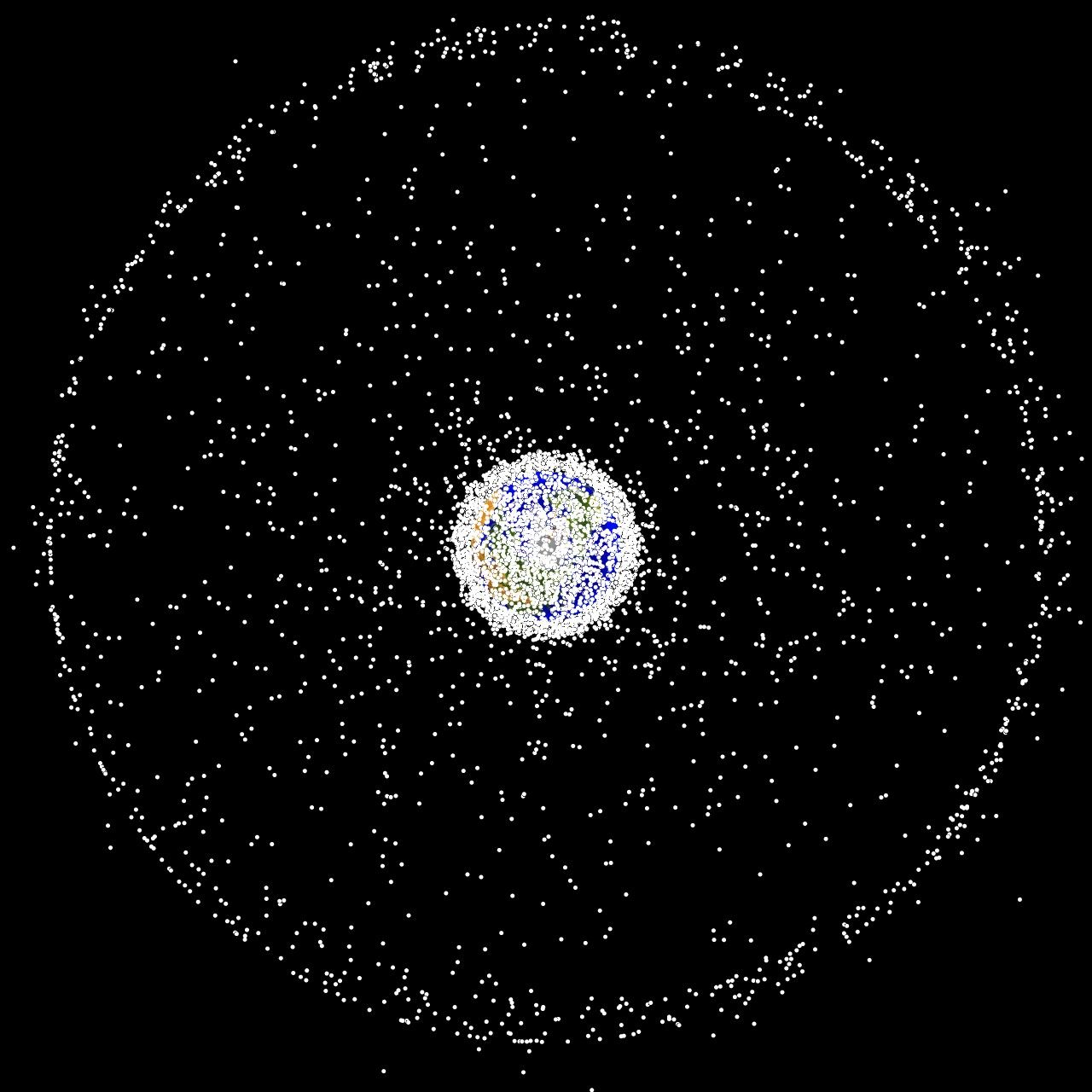On Friday, July 19th, China’s Tiangong-2 (“Heavenly Palace”) space laboratory successfully entered Earth’s atmosphere under controlled conditions and burned up above the South Pacific Ocean. This marked the successful completion of all of Tiangong-2’s tasks, which constituted China’s second attempt at testing their capability to conduct research and human operations in Low Earth Orbit (LEO).
Continue reading “China’s Tiangong 2 was Destroyed Last Week, Burning up in the Atmosphere Over the South Pacific Ocean”China is Working on Their Own Reusable Rocket: the First Stage of the Long March-8, Which Could Launch in 2021
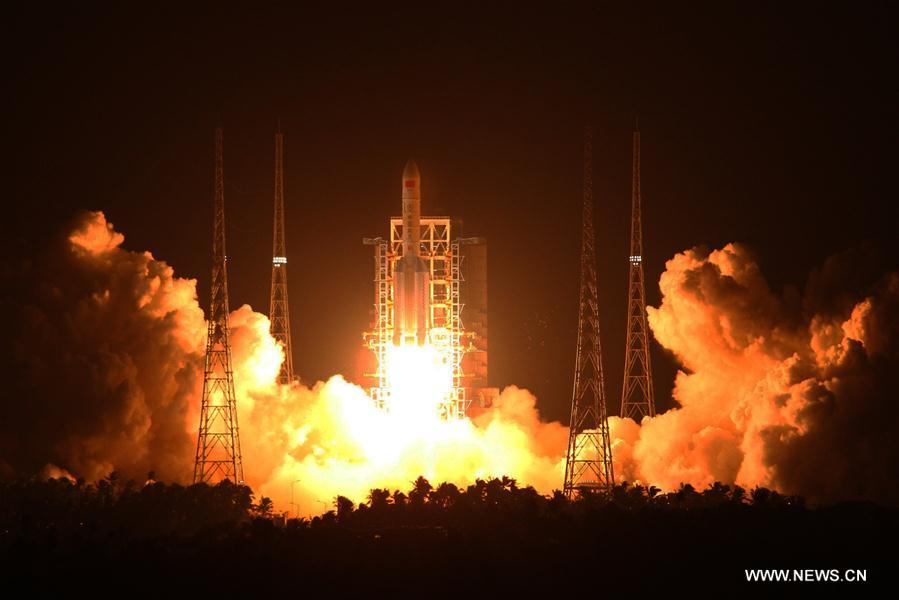
In recent decades, China’s space program has advanced considerably. In addition to deploying their first space station (Tiangong-1) and developing a modern rockets (the Long March 5), the nation has also sent robotic mission to the lunar surface and plans to conduct crewed missions there in the coming years. To this end, China is looking to create a new series of rockets that will enable them to explore the Moon and maybe even Mars.
One of the rockets they use to accomplish these goals is known as the Long-March 8, which is expected to make its maiden flight around 2021. According to a statement made by the chief rocket designer (Long Lehao) during a recent space conference in Harbin, China, the rocket will also include a reusable first stage. This latest announcement shows that China is also pursuing reusable launch vehicles to lower costs and increase their presence in space.
According to the China Space Report, the Long March 8 (Changzheng 8, or CZ-8) is a medium-lift vehicle intended for Sun-Synchronous Orbit (SSO) missions – i.e. where payloads are delivered to a nearly polar orbit around a planet. Consisting of two stages and two boosters, this rocket will reportedly have a payload capacity of 3000 to 4,500 kg (6600 to 9900 lbs) to SSO.
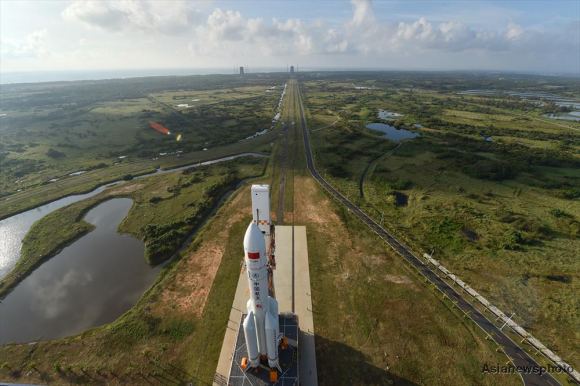
The first stages on this rocket are believed to be based on the first-stage of the Long March 7, which are powered by two single-chamber YF-100, 1,200 kN-thrust engines fueled by LOX/kerosene. Based on Long’s statement, the first stages and boosters are expected to be retrieved through vertical landing (similar to SpaceX’s Falcon 9 and Falcon Heavy rockets).
However, according to Bao Weimin, the director of the Science and Technology Commission of the China Aerospace Science and Technology Corporation, the Long March 8 will use different technologies that those employed by SpaceX. The purpose of this rocket will be to provide commercial launch services to customers from around the world.
As Long indicated during the course of the conference (according to China Daily):
“China’s aerospace industry is making efforts to develop low-cost vehicles that can enter space rapidly to support future large-scale space exploration and promote a commercial space industry.”
In addition, Long also emphasized that China will be making efforts to address an ongoing problem with its younger Long March rockets, which is controlling where they fall. Currently, landing areas have to be are evacuated at every launch since these rockets rely on toxic chemicals. And with launches becoming more frequent, controlling where these rockets fall is becoming a major priority.
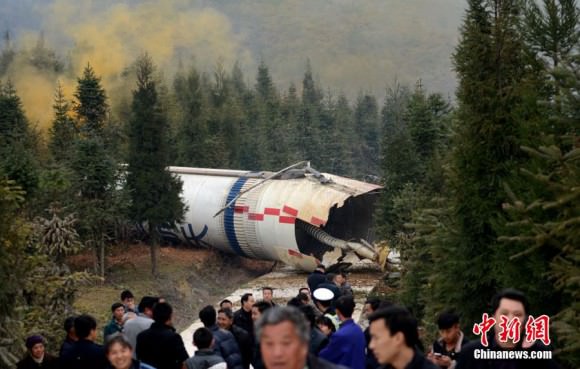
“As the current Long March 2, 3, 4 series rockets are fueled by toxic propellants, they cannot be recycled,” said Long. “But we are developing technologies to precisely control the fall of the rocket remains to ensure safety.”
Lastly, Long indicated what lies ahead for China’s space program and commercial spaceflight. By 2025, he claimed, reusable carriers will be developed for conducting suborbital space flights. By 2030, China National Space Agency will be conducting launches with rockets that rely on two reusable stages and will have achieved complete reusability by 2035. He also hinted how by 2040, China will be using reusable carrier rockets that will rely on hybrid-power sources.
All of this will allow for cheaper and more efficient launch services, facilitate spaceflight for private citizens, and allow for the commercialization of Low Earth Orbit (LEO). These goals are in keeping with what space agencies like NASA and private aerospace companies like SpaceX have in mind for the coming decades. In this sense, China is indicating that it intends to parallel other major powers in space by following a similar path.
Further Reading: China Daily
Tiangong-1 Splashes Down in the Pacific Ocean
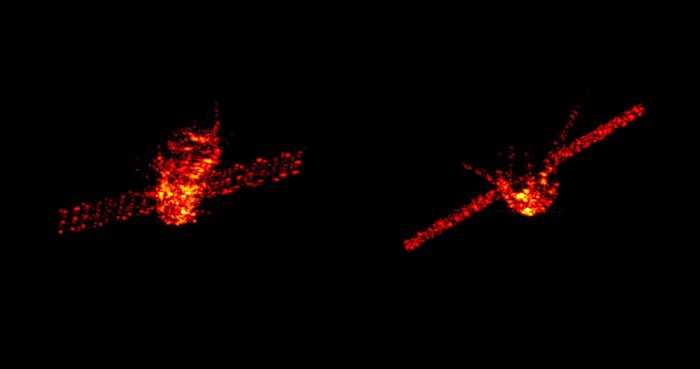
Over the weekend, multiple space agencies’ had their instruments fixed on the skies as they waited for the Tiangong-1 space station to reenter our atmosphere. For the sake of tracking the station’s reentry, the ESA hosted the 2018 Inter Agency Space Debris Coordination Committee, an annual exercise that consists of experts from 13 space agencies taking part in a joint tracking exercise.
And on April 2nd, 02:16 CEST (April 1st, 17:16 PST), the US Air Force confirmed the reentry of the Tiangong-1 over the Pacific Ocean. As hoped, the station crashed down close to the South Pacific Ocean Unpopulated Area (SPOUA), otherwise known as the “Spaceship Cemetery”. This region of the Pacific Ocean has long been used by space agencies to dispose of spent spacecraft after a controlled reentry.
The confirmation came from the Joint Force Space Component Command (JFSCC) on April 2nd, 0:400 CEST (April 1st, 19:00 PST). Using the Space Surveillance Network sensors and their orbital analysis system, they were able to refine their predictions and provide more accurate tracking as the station’s reentry time approached. The USAF regularly shares information with the ESA regarding its satellites and debris tracking.
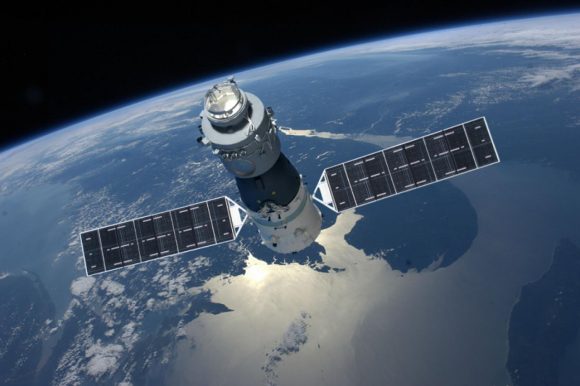
As with the ESA’s coordination with other space agencies and European member states, JFSCC’s efforts include counterparts in Australia, Canada, France, Germany, Italy, Japan, South Korea, and the United Kingdom. As Maj. Gen. Stephen Whiting, the Deputy Commander of the JFSCC and Commander of the 14th Air Force, indicated in a USAF press release:
“The JFSCC used the Space Surveillance Network sensors and their orbital analysis system to confirm Tiangong-1’s reentry, and to refine its prediction and ultimately provide more fidelity as the reentry time approached. This information is publicly-available on USSTRATCOM’s website www.Space-Track.org. The JFSCC also confirmed reentry through coordination with counterparts in Australia, Canada, France, Germany, Italy, Japan, South Korea, and the United Kingdom.”
The information is available on U.S. Strategic Command’s (USSTRATCOM) website – www.Space-Track.org. Holger Krag, the head of ESA’s Space Debris Office, confirmed the reentry of Tiangong-1 shortly thereafter on the ESA’s Rocket Science Blog. As he stated, the reentry was well within ESA’s earlier reentry forecast window – which ran from April 1st 23:00 UTC to 03:00 UTC on April 2nd (April 2nd, 01:00 CEST to 05:00 CEST):
“According to our experience, their assessment is very reliable. This corresponds to a geographic latitude of 13.6 degrees South and 164.3 degrees West – near American Samoa in the Pacific, near the international date Line. Both time and location are well within ESA’s last prediction window.”
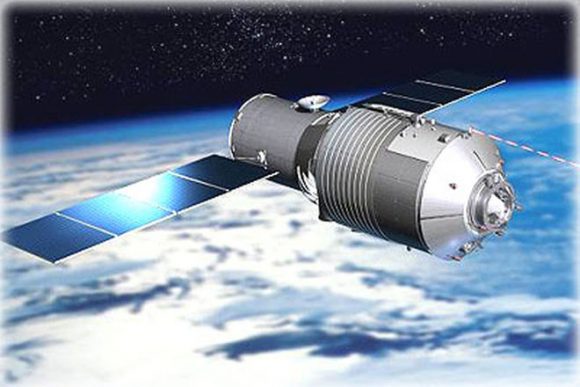
China’s Manned Space Agency (CMSA) also made a public statement about the station’s reenty:
“According to the announcement of China Manned Space Agency (CMSA), through monitoring and analysis by Beijing Aerospace Control Center (BACC) and related agencies, Tiangong-1 reentered the atmosphere at about 8:15 am, 2 April, Beijing time. The reentry falling area located in the central region of South Pacific. Most of the devices were ablated during the reentry process.”
As Krag noted, the ESA’s monitoring efforts were very much reliant on its campaign partners from around the world. In fact, due to when the station entered the Earth’s atmosphere, it was no longer visible to the Fraunhofer FHR institute’s Tracking and Imaging (TIRA) radar, which provides tracking services for the ESA’s Space Debris Office (SDO).
Had the station still been in orbit by 06:05 CEST (21:00 PST), it would have still been visible to the institute’s TIRA radar. Some unexpected space weather also played a role in the station’s reentry. On March 31st, the Sun’s activity spontaneously dropped, which delayed the Tiangong-1’s entry by about a day.
“This illustrates again the dependence that Europe has on non-European sources of information to properly and accurately manage space traffic, detect reentries such as Tiangong-1 and track space debris that remains in orbit – which routinely threatens ESA, European and other national civil, meteorological, scientific, telecomm and navigation satellites,” said Krag.
While news of the Tiangong-1’s orbital decay caused its share of concern, the reentry happened almost entirely as predicted and resulted in no harm. And once again, it demonstrated how international cooperation and public outreach is the best defense against space-related hazards.
Further Reading: Vandenburg Air Force Base,
Did You Know That a Satellite Crashes Back to Earth About Once a Week, on Average?
This past weekend, a lot of attention was focused on the Tiangong-1 space station. For some time, space agencies and satellite trackers from around the world had been predicting when this station would fall to Earth. And now that it has safely landed in the Pacific Ocean, many people are breathing a sigh of relief. While there was very little chance that any debris would fall to Earth, the mere possibility that some might caused its share of anxiety.
Interestingly enough, concerns about how and when Tiangong-1 would fall to Earth has helped to bring the larger issue of orbital debris and reentry into perspective. According to the SDO, on average, about 100 tonnes of space junk burns up in Earth’s atmosphere every year. Monitoring these reentries and warning the public about possible hazards has become routine work for space debris experts.
This junk takes the form of defunct satellites, uncontrolled spacecraft, the upper stages of spent rockets, and various discarded items (like payload covers). Over time, this debris is slowed down by Earth’s upper atmosphere and then succumbs to Earth’s gravitational pull. Where larger objects are concerned, some pieces survive the fiery reentry process and reach the surface.
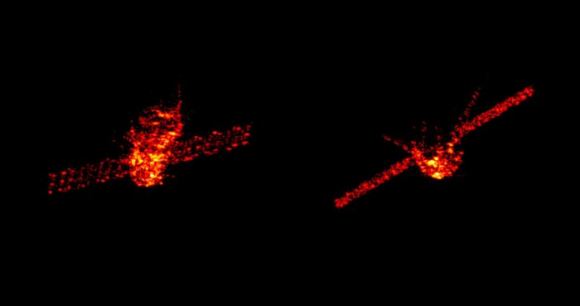
In most cases, this debris falls into the ocean or lands somewhere far away from human settlement. While still in orbit, these objects are tracked by a US military radar network, the ESA’s Space Debris Office, and other agencies and independent satellite trackers. This information is shared in order to ensure that margins of error can be minimized and predicted reentry windows can be kept narrow.
For the SDO team, these efforts are based on data and updates provided by ESA member states and civil authorities they are partnered with, while additional information is provided by telescopes and other detectors operated by institutional and private researchers. One example is the Tracking and Imaging Radar (TIRA) operated by the Fraunhofer Institute for High Frequency Physics and Radar Techniques near Bonn, Germany.
This is a challenging task, and often subject to a measure of imprecision and guesswork. As Holger Krag, the head of ESA’s Space Debris Office, explained:
“With our current knowledge and state-of-the-art technology, we are not able to make very precise predictions. There will always be an uncertainty of a few hours in all predictions – even just days before the reentry, the uncertainty window can be very large. The high speeds of returning satellites mean they can travel thousands of kilometres during that time window, and that makes it very hard to predict a precise location of reentry.”
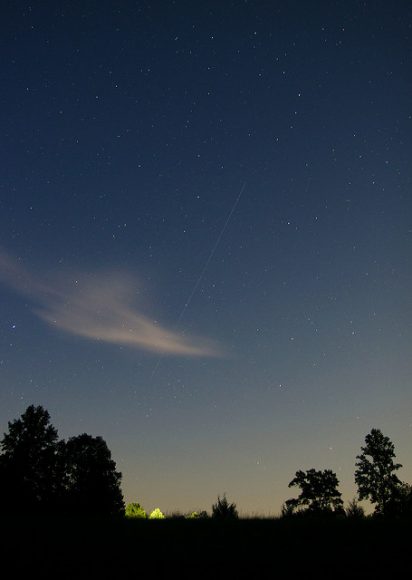
Of the 100 tonnes that enters our atmosphere every year, the vast majority are small pieces of debris that burn up very quickly – and therefore pose no threat to people or infrastructure. The larger descents, of which there are about 50 per year, sometimes result in debris reaching the surface, but these generally land in the ocean or remote areas. In fact, in the history of spaceflight, no casualties have ever been confirmed by falling space debris.
The ESA also takes part in a joint tracking campaign run by the Inter Agency Space Debris Coordination Committee, which consists of experts from 13 space agencies. In addition to the ESA, this committee includes several European space agencies, NASA, Roscosmos, the Canadian Space Agency, the Japanese Aerospace Exploration Agency, the Indian Space Research Organization, the China National Space Agency, and the State Space Agency of Ukraine.
The purpose of these campaigns is for space agencies to pool their respective tracking information from radar and other sources. In so doing, they are able to analyze and verify each other’s data and improve prediction accuracy for all members. The ESA hosted the 2018 campaign, which followed the reentry of China’s Tiangong-1 space station as it entered Earth’s atmosphere this weekend – the details of which are posted on the ESA’s Rocket Science blog.
“Today, everyone in Europe relies on the US military for space debris orbit data – we lack the radar network and other detectors needed to perform independent tracking and monitoring of objects in space,” said Krag. “This is needed to allow meaningful European participation in the global efforts for space safety.”
While predicting when and where space debris will reenter our atmosphere may not yet be an exact science, it does have one thing going for it – its 100% safety record. And as the Tiangong-1 descent showed, early warning and active tracking ensure that potential threats are recognized well in advance.
In the meantime, be sure to enjoy this video on the Space Debris Office’s reentry monitoring, courtesy of the ESA:
Further Reading: ESA
Here’s How to Follow the De-Orbit of Tiangong-1, now Estimated to Happen Between March 30 and April 2
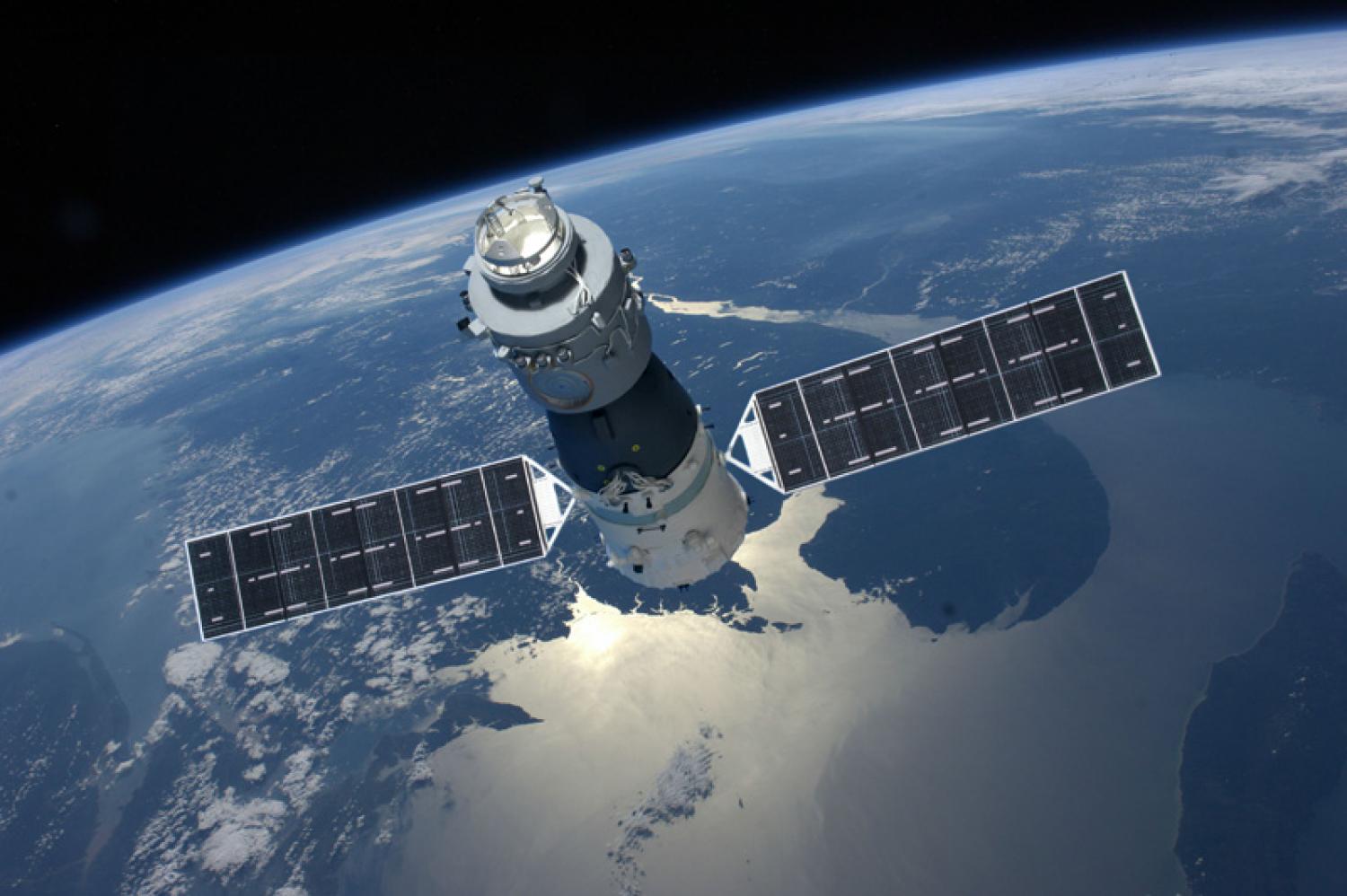
China’s Tiangong-1 space station has been the focus of a lot of international attention lately. In 2016, after four and half years in orbit, this prototype space station officially ended its mission. By September of 2017, the Agency acknowledged that the station’s orbit was decaying and that it would fall to Earth later in the year. Since then, estimates on when it will enter out atmosphere have been extended a few times.
According to satellite trackers, it was predicted that the station would fall to Earth in mid-March. But in a recent statement (which is no joke) the Chinese National Space Agency (CNSA) has indicated that Tiangong-1 will fall to Earth around April 1st – aka. April Fool’s Day. While the agency and others insists that it is very unlikely, there is a small chance that the re-entry could lead to some debris falling to Earth.
For the sake of ensuring public safety, the European Space Agency’s (ESA) Space Debris Office (SDO) has been providing regular updates on the station’s decay. According to the SDO, the reentry window is highly variable and spans from the morning of March 31st to the afternoon of April 1st (in UTC time). This works out to the evening of March 30th or March 31st for people living on the West Coast.
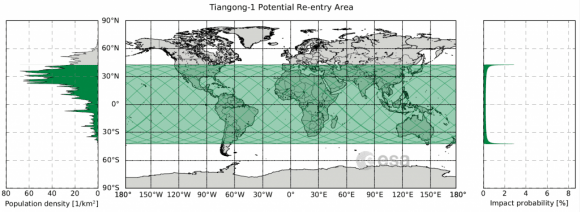
As the ESA stated on their rocket science blog:
“Reentry will take place anywhere between 43ºN and 43ºS. Areas above or below these latitudes can be excluded. At no time will a precise time/location prediction from ESA be possible. This forecast was updated approximately weekly through to mid-March, and is now being updated every 1~2 days.”
In other words, if any debris does fall to the surface, it could happen anywhere from the Northern US, Southern Europe, Central Asia or China to the tip of Argentina/Chile, South Africa, or Australia. Basically, it could land just about anywhere on the planet. On the other hand, back in January, the US-based Aerospace Corporation released a comprehensive analysis on Tiangong-1s orbital decay.
Their analysis included a map (shown below) which illustrated the zones of highest risk. Whereas the blue areas (that make up one-third of the Earth’s surface) indicate zones of zero probability, the green area indicates a zone of lower probability. The yellow areas, meanwhile, indicates zones that have a higher probability, which extend a few degrees south of 42.7° N and north of 42.7° S latitude, respectively.
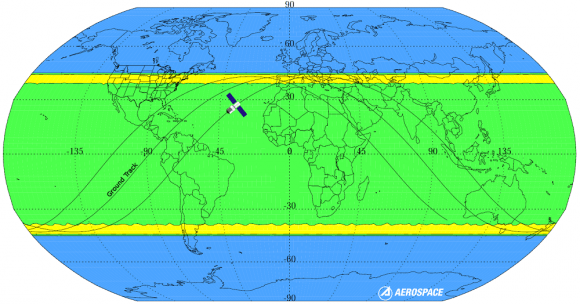
The Aerospace Corporation has also created a dashboard for tracking Tiangong-1 (which is refreshed every few minutes) and has come to similar conclusions about the station’s orbital decay. Their latest prediction is that the station will descend into our atmosphere on April 1st, at 04:35 UTC (March 30th 08:35 PST), with a margin of error of about 24 hours – in other words, between March 30th to April 2nd.
And they are hardly alone when it comes to monitoring Tiangong-1’s orbit and predicting its descent. The China Human Spaceflight Agency (CMSA) recently began providing daily updates on the orbital status of Tiangong-1. As they reported on March 28th: “Tiangong-1 stayed at an average altitude of about 202.3 km. The estimated reentry window is between 31 March and 2 April, Beijing time.”
The US Space Surveillance Network, which is responsible for tracking artificial objects in Earth’s orbit, has also been monitoring Tiangong-1 and providing daily updates. Based on their latest tracking data, they estimate that the station will enter our atmosphere no later than midnight on April 3rd.
Naturally, one cannot help but notice that these predictions vary and are subject to a margin of error. In addition, trackers cannot say with any accuracy where debris – if any – will land on the planet. As Max Fagin – an aerospace engineer and space camp alumni – explained in a recent Youtube video (posted below), all of this arises from two factors: the station’s flight path and the Earth’s atmosphere.
Basically, the station is still moving at a velocity of 7.8 km/sec (4.8 mi/s) horizontally while it is descending by about 3 cm/sec. In addition, the Earth’s atmosphere shrinks and expands throughout the day in response to the Sun’s heating, which results in changes in air resistance. This makes the process of knowing where the station’s will make its descent difficult to predict, not to mention where debris could fall.
However, as Fagin goes on to explain, once the station reaches an altitude of 150 km (93 mi) – i.e. within the Thermosphere – it will begin falling much faster. At that point, it be much easier to determine where debris (if any) will fall. However, as the ESA, CNSA, and other trackers have emphasized repeatedly, the odds of any debris making it to the surface is highly unlikely.
If any debris does survive re-entry, it is also statistically likely to fall into the ocean or in a remote area – far away from any population centers. But in all likelihood, the station will break up completely in our atmosphere and produce a beautiful streaking effect across the sky. So if you’re checking the updates regularly and are in a part of the world where it can be seen, be sure to get outside and see it!
Further Reading: GB Times
Tiangong 1 Falls, Blue Moon Rises and Mars Takes Aim At Saturn

I apologize for the end-of-the-world title, but everything in it is true. And the world will still be here after it’s all done. On Friday (March 31) at 7:36 a.m. Central Time, the Moon will be full for the second time this month, which makes it a Blue Moon according to popular usage. Enjoy it. What with January’s Blue Moon and now this, we’ve chewed through all our Blue Moons till Halloween 2020.
I look forward to every full moon. Watching a moonrise, we get to see all manner of amazing atmospheric distortions play across the squat, orange disk. Once the sky’s dark, its outpouring of light makes walking at night a pleasure.
When a full moon occurs in spring, it hurries south down the ecliptic, the imaginary circle in the sky defining Earth’s orbit around the Sun. For northern hemisphere skywatchers, this southward sprint delays its rising by more an hour each night, forcing a quick departure from the evening sky. And that means blessed darkness for hunting down favorite galaxies and star clusters.
Tiangong 1 and a reentry simulation
As the Moon rolls along, the hapless Chinese space station Tiangong 1 hurtles toward Earth. Drag caused by friction with the upper atmosphere continues to shrink the spacecraft’s orbit, bringing it closer and closer to inevitable breakup and incineration. Since the Chinese National Space Administration (CNSA) lost touch with Tiangong 1 in March 2016, mission control can no longer power thrusters to de-orbit it at chosen time over a safe location like the ocean. The 9.3-ton (8,500 kg) station will burn up somewhere anywhere over a vast swath of the planet between latitudes 43°N and 43°S. Included within this zone are the southern half of Europe, the southern two-thirds of the U.S., India, Australia and much of Africa and South America.
Not until the day of or even hours before will have a clear idea of when and where the station will meet its fate. According to the latest update from the Aerospace Corp., which monitors falling spacecraft, reentry is expected on Easter Sunday (April 1) at 10:30 UT / 5:30 a.m. Central Time plus or minus 16 hours. This morning (March 29), the space station is circling Earth at about 118 miles (190 km) altitude. The lowest a satelllite can still make a complete orbit of the planet is about 62 miles (100 km). Below that, break-up begins.
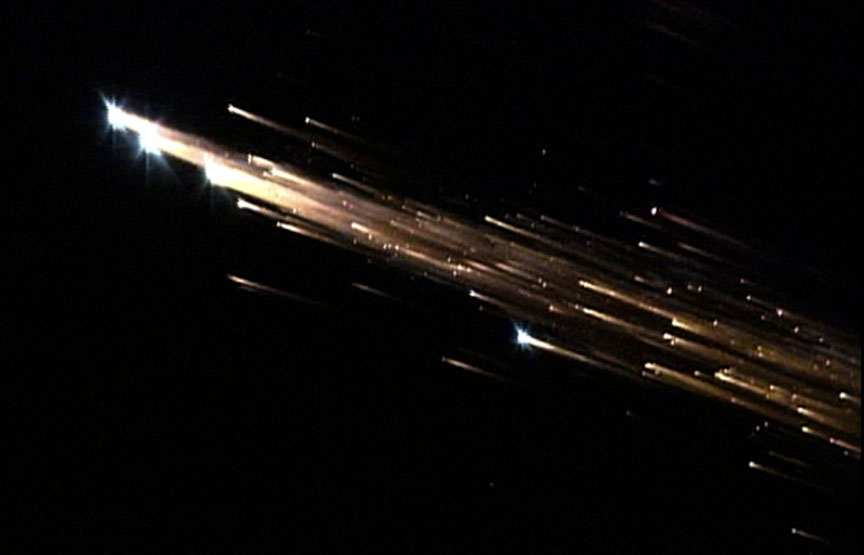
For up-to-the-minute updates on when to expect Tiangong 1’s orbit to decay and the machine to plunge to Earth, check out Joseph Remis’ Twitter page. Most of the space station is expected to burn up on reentry, but larger chunks might survive all the way to the ground. Since much more of the Earth’s surface is water these remnants will likely end up in the drink … but you never know. If Tiangong-1 does come down over a populated area, observers on the ground will witness a spectacular, manmade fireball day or night.

On the quieter side but nearly as eye-catching, Mars will overtake Saturn in the coming week, passing just 1° south of the ringed planet in a thrilling dawn conjunction on April 2. If the weather forecast doesn’t look promising that morning, the two planets will remain within 2° of each other now through April 6th, providing plenty of opportunities for a look.
You can easily tell them apart by color: Mars is distinctly red-orange and Saturn looks creamy white. Both are bright at around magnitude 0 though Mars is now a hair brighter by two-tenths of a magnitude. Will you be able to see the difference?
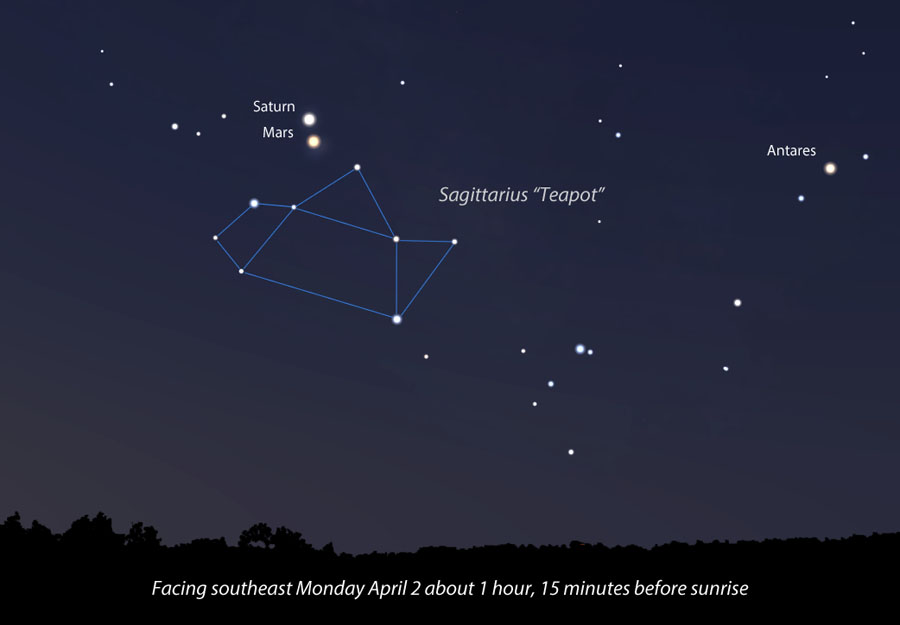
In most telescopes at low magnification both planets will comfortably fit in the same field of view. Saturn’s rings are tilted nearly wide open and quite beautiful. Mars appears gibbous and though still rather small, it’s brightening rapidly and drawing closer in time for its closest approach to Earth since 2003. Wishing you clear skies!
China Says it Still has Control Over Tiangong-1 and Can Decide Where It’ll Crash

The Tiangong-1 space station has been the subject of a lot of interest lately. Though its mission was meant to end in 2013, the China National Space Agency extended its service until 2016. In September of 2017, after much speculation from the international community, the Agency acknowledged that the station’s orbit was degrading and that it would fall to Earth later in the year.
Based on updates from satellite trackers, it has been indicated that Tianglong-1 will likely reenter our atmosphere in March of 2018, with the possibility of debris making it to the surface. However, according to a statement made by a top engineer at the China Aerospace Science and Technology Corporation (CASTC), reports that the Chinese National Space Agency (CNSA) has lost control of the space station have been wildly exaggerated.
The statement came from Zhu Congpeng, a top engineer at the China Aerospace Science and Technology Corporation (CASTC). As he was quoted as saying to the Science and Technology Daily newspaper – a state-backed Chinese science journal – the CNSA is still in control of the space station, it’s reentry will be controlled, and it will not pose a threat to the environment or any population centers.

Previously, the CNSA claimed that the majority of the station would burn up in orbit, with only small pieces falling to the Earth. But according to Zhu Congpeng’s statement, when the station burns up in the atmosphere, the remaining debris will not jeopardize people, infrastructure or the environment anywhere on the surface. As Zhu Congpeng stated:
“We have been continuously monitoring Tiangong-1 and expect to allow it to fall within the first half of this year. It will burn up on entering the atmosphere and the remaining wreckage will fall into a designated area of the sea, without endangering the surface.”
As with previous missions – like the Mir space station, the Russian Progress spacecraft, and NASA’s Compton Gamma-Ray Observatory – the designated crash site is a deep-sea area in the South Pacific known as the “spacecraft cemetery”. As a further indication that the CNSA is still in control of Tiangong-1, Zhu claimed that the CNSA has been constantly monitoring the space station since the end of its mission.
“The latest bulletin shows that on December 17-24, 2017, Temple One runs on an orbit with an average height of about 286.5 kilometers (height of about 272.6 kilometers near perigee, height of about 300.4 kilometers at apogee and inclination of about 42.85 degrees), attitude stability,” he said. “There is no abnormal morphology.”

He also emphasized that the station’s reentry was delayed until September in order to ensure the the wreckage would fall into the South Pacific. In other words, the position of Tiangong-1 is something the Chinese have been monitoring closely, and they will continue to do so when it reenters the atmosphere this coming March. This latest statement comes on the heels of statements made by both China’s manned space engineering office and the Aerospace Corporation, which appeared to offer a different appraisal.
Back in mid-September, Wu Ping – the deputy director of China’s manned space engineering office – stated at a press conference that there was some chance that debris would land on Earth. While she was insistent that the odds of any debris surviving the passage through Earth’s atmosphere were minimal, it did suggest that the reentry would be uncontrolled.
This echoed the comprehensive report recently issued by the Aerospace Corporation, which stated that the Chinese space agency was unlikely to remain in control of Tiangong-1’s for the entirety of its reentry. Much like Wu, they also emphasized that the majority of the station would burn up on reentry and that it was unlikely that any debris would make it to the surface and cause damage.
As such, its not entirely clear if the reentry will be entirely controlled or not. But even if it should prove to be the latter, there is little reason to worry. As the Aerospace Corporation stated in their report:
“[T]he probability that a specific person (i.e., you) will be struck by Tiangong-1 debris is about one million times smaller than the odds of winning the Powerball jackpot. In the history of spaceflight, no known person has ever been harmed by reentering space debris. Only one person has ever been recorded as being hit by a piece of space debris and, fortunately, she was not injured.”
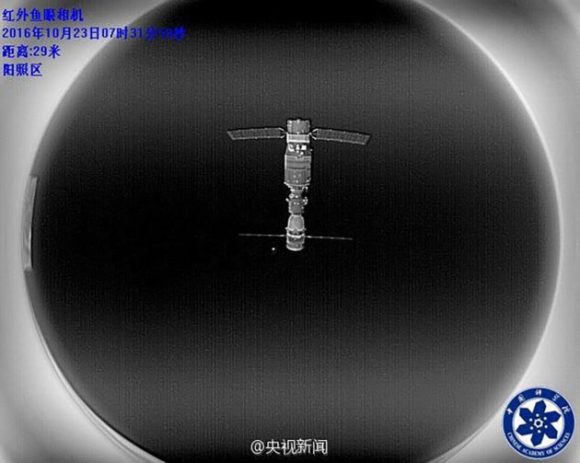
On top of that, the European Space Agency’s Inter Agency Space Debris Coordination Committee (IADC) will also be monitoring the reentry closely. They’ll also be using the occasion to conduct a test campaign designed to improve the accuracy of reentry predictions. And so far, all their predictions indicate that come March, people on Earth will be safe from falling debris.
So if you happen to live close to the equator, this coming March is sure to be an exciting time for sky-watchers! And if there’s any chance of debris landing where you live, you can sure you’ll hear about it well in advance.
Further Reading: Independent, STDaily
In mid-March, the Chinese Tiangong-1 Space Station is Going to Come Crashing Back Down to Earth… Somewhere

In September of 2011, China officially joined the Great Powers in Space club, thanks to the deployment of their Tiangong-1 space station. Since then, this prototype station has served as a crewed orbital laboratory and an experimental testbed for future space stations. In the coming years, China hopes to build on the lessons learned with Tiangong-1 to create a larger, modular station in 2023 (similar to the International Space Station).
Though the station’s mission was originally meant to end in 2013, the China National Space Agency extended its service to 2016. By September of 2017, the Agency acknowledged that they had lost control of the station and indicated that it would fall to Earth later in the year. According to the latest updates from satellite trackers, Tianglong-1 is likely to be reentering our atmosphere in March of 2018.
Given the fact that the station measures 10 by 3.35 meters (32.8 by 11 ft), weighs a hefty 8,506 kg (18,753 lb) and was built from very durable construction materials, there are naturally concerns that some of it might survive reentry and reach the surface. But before anyone starts worrying about space debris falling on their heads, there are a few things that need to be addressed.
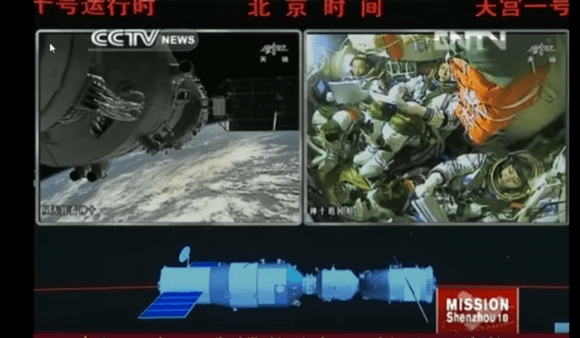
For starters, in the history of space flight, there has not been a single confirmed death caused by falling space debris. Tthanks to the development of modern tracking and early warning systems, we are also more prepared than at any time in our history for the threat of falling debris. Statistically speaking, you are more likely to be hit by falling airplane debris or eaten by a shark.
Second, the CNSA has emphasized that the reentry is very unlikely to pose a threat to commercial aviation or cause any impact damage on the surface. As Wu Ping – the deputy director of the manned space engineering office – indicated at a press conference back on September 14th, 2017: “Based on our calculation and analysis, most parts of the space lab will burn up during falling.”
In addition, The Aerospace Corporation, which is currently monitoring the reentry of Tiangong-1, recently released the results of their comprehensive analysis. Similar to what Wu stated, they indicated that most of the station will burn up on reentry, though they acknowledged that there is a chance that small bits of debris could survive and reach the surface. This debris would likely fall within a region that is centered along the orbital path of the station (i.e. around the equator).
To illustrate the zones of highest risk, they produced a map (shown below) which indicates where the debris would be most likely to land. Whereas the blue areas (that make up one-third of the Earth’s surface) indicate zones of zero probability, the green area indicates a zone of lower probability. The yellow areas, meanwhile, indicates zones that have a higher probability, which extend a few degrees south of 42.7° N and north of 42.7° S latitude, respectively.

To add a little perspective to this analysis, the company also indicated the following:
“When considering the worst-case location (yellow regions of the map) the probability that a specific person (i.e., you) will be struck by Tiangong-1 debris is about one million times smaller than the odds of winning the Powerball jackpot. In the history of spaceflight, no known person has ever been harmed by reentering space debris. Only one person has ever been recorded as being hit by a piece of space debris and, fortunately, she was not injured.”
Last, but not least, the European Space Agency’s Inter Agency Space Debris Coordination Committee (IADC) will be monitoring the reentry. In fact, the IADC – which is made up of space debris and other experts from NASA, the ESA, JAXA, ISRO, KARI, Roscosmos and the China National Space Administration – will be using this opportunity to conduct a test campaign.
During this campaign, participants will combine their predictions of the reentry’s time window, which are based on respective tracking datasets obtained from radar and other sources. Ultimately, the purpose of the campaign is to improve prediction accuracy for all member states and space agencies. And so far, their predictions also indicate that there is little cause for concern.
As Holger Krag, the Head of ESA’s Space Debris Office, indicated in a press statement back in November:
“Owing to the geometry of the station’s orbit, we can already exclude the possibility that any fragments will fall over any spot further north than 43ºN or further south than 43ºS. This means that reentry may take place over any spot on Earth between these latitudes, which includes several European countries, for example. The date, time and geographic footprint of the reentry can only be predicted with large uncertainties. Even shortly before reentry, only a very large time and geographical window can be estimated.”
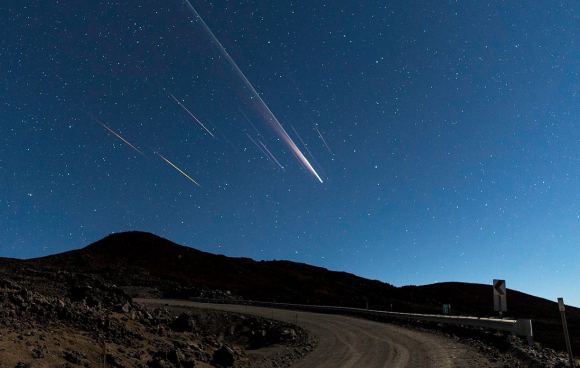
The ESA’s Space Debris Office – which is based at the European Space Operations Centre in Darmstadt, Germany – will follow this campaign in February with an international expert workshop. This workshop (which will run from February 28th to March 1st, 2018) will focus on reentry predictions and atmospheric break-up studies and allow experts in the field of space debris monitoring to share their latest findings and research.
In the current age of renewed space exploration and rapidly improving technology, every new development in space is an opportunity to test the latest instruments and methods. The reentry of Tiangong-1 is a perfect example, where the reentry of a space station is being used to test our ability to predict falling space debris. It also highlights the need for tracking and monitoring, given that humanity’s presence in orbit is only going to increase in the coming years.
In the meantime, it would not be inadvisable to keep your eyes on the skies this coming March. While there is little chance that debris will pose a hazard, it is sure to be spectacular sight for people who live closer to the equator!
Further Reading: Aerospace.org, ESA, Xinhuanet
Weekly Space Hangout – Sept 23, 2016: Dr. Frank Timmes and Online Astronomy Education
Host: Fraser Cain (@fcain)
Special Guests:
Dr. Frank Timmes is an astrophysicist at Arizona State University and will be discussing online astronomy education and the Global Freshman Academy. His interests include the universe’s evolving composition and its implications for life in the universe. Dr. Timmes’ current area of research is nuclear astrophysics and the creation of the periodic table.
Guests:
Morgan Rehnberg (MorganRehnberg.com / @MorganRehnberg)
Dave Dickinson (www.astroguyz.com / @astroguyz)
Kimberly Cartier ( KimberlyCartier.org / @AstroKimCartier )
Nicole Gugliucci (cosmoquest.org / @noisyastronomer)
Their stories this week:
New bill targets serial harasses
Microlensing circumbinary planet detected
Repeat of Voyager’s “impossible” cloud
We are now using a tool called Trello to submit and vote on stories we would like to see covered each week, and then Fraser will be selecting the stories from there. Here is the link to the Trello WSH page (http://bit.ly/WSHVote), which you can see without logging in. If you’d like to vote, just create a login and help us decide what to cover!
We record the Weekly Space Hangout every Friday at 12:00 pm Pacific / 3:00 pm Eastern. You can watch us live on Universe Today, or the Universe Today YouTube page.
How To See the Doomed Tiangong-1 Chinese Space Station

China’s first space station, Tiangong-1, is expected to fall to Earth sometime in late 2017. We’ve known for several months that the orbital demise of the 8-metric ton space station was only a matter of time. But Chinese space agency officials recently confirmed that they have lost telemetry with the space station and can no longer control its orbit. This means its re-entry through Earth’s atmosphere will be uncontrolled.
Despite sensational headlines this past week (and earlier this year) about Tiangong-1 exploding and raining down molten metal, the risk is quite low that people on Earth will be in danger. Any remaining debris that doesn’t burn up in the atmosphere has a high chance of falling into an ocean, since two-thirds of Earth’s surface is covered by water.

While NASA and other space agencies say it’s very hard to compute the overall risk to any individual, it’s been estimated that the odds that you, personally, will be hit by a specific piece of debris are about 1 in several trillion.
But numerically, the chance that one person anywhere in the world might be struck by a any piece of space debris comes out to a chance of 1-in-3,200, said Nick Johnson, chief scientist with NASA’s Orbital Debris during a media teleconference in 2011 when the 6-ton UARS satellite was about to make an uncontrolled reentry.
Johnson also reminded everyone that throughout the entire history of the space age, there have been no reports of anybody in the world being injured or struck by any re-entering debris. Something of this size re-enters the atmosphere every few years, and many are uncontrolled entries. For example, there were the UARS and ROSAT satellites in 2011, GOCE in 2013 and Kosmos 1315 in 2015. All of those re-entered without incident, with some returning so remotely there was no visual evidence of their fall.
Wu Ping, deputy director of China’s Manned Space Engineering (CMSE) office, said at a press conference before the launch of the Tiangong-2 space station last week (September 15, 2016) that based on their calculations and analysis, most parts of the space lab will burn up during its fall through the atmosphere. She added that China has always highly valued the management of space debris, and will continue to monitor Tiangong-1, and will release a forecast of its falling and report it internationally.

So, all that can be done now is to monitor its position over time to be able to predict when and where it might come down.
Without telemetry, how can we monitor its orbital position?
“Although Tiangong-1 is no longer functioning, keeping track of where it is not a problem,” said Chris Peat, who developed and maintains Heavens-Above.com, a site that provides orbital information to help people observe and track satellites orbiting the Earth.
“Like all other satellites, it is being tracked by the world-wide network of radar installations operated by the US Department of Defense,” Peat explained via email to Universe Today. “They make the orbital elements available to the public via the Space-Track web site and this is where we get the orbital data from in order to make our predictions.”
Peat says they check for new data every 4 hours, and Space-Track updates the orbits of most large objects about once per day.
Since Tiangong-1 is such a large object, Peat said there is no chance that it will be lost by Space-Track before re-entry. Additionally, amateur/hobby observers also make observations of the position of some satellites and calculate their own orbits for them. This is mostly done for classified satellites for which Space-Track does not publish data, and is not really necessary in the case of Tiangong-1, Peat said.
But with uncertainties of when and where this 8-ton (7.3 metric tons) vehicle will come back to Earth, you can bet that the amateur observing community will keep an eye on it.
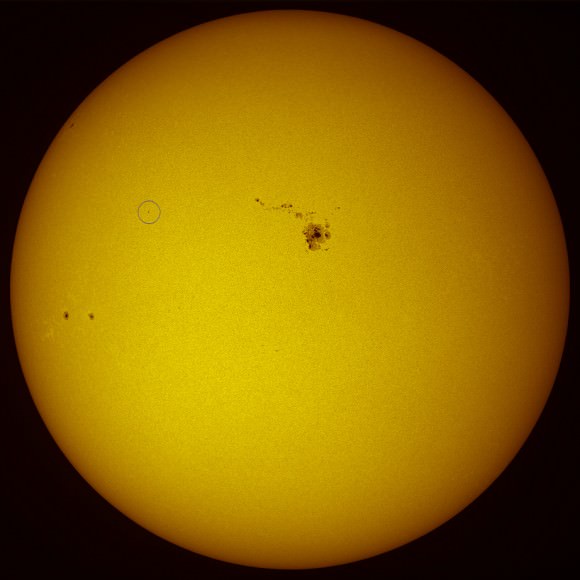
“As it gets lower and enters the denser atmosphere, it will be subject to greater perturbations, but I do not expect Space-Track to lose it because it is so large,” Peat said. “It will actually become brighter and easier to see as it gets lower.”
If you want to watch for it yourself, Heavens-Above provides tracking information anywhere around the world. Just input your specific location and click on “Tiangong-1,” listed under “Satellites.” Heavens-Above (they also have an app) is great for being able to see satellites like the International Space Station and Hubble, as well as seeing astronomical objects like planets and asteroids. Heavens-Above also has an interactive sky chart.
Additionally, Marco Di Lorenzo on the Alive Universe website is monitoring Tiangong-1’s orbit, showing the orbital decay over time. He will be updating its status up through re-entry.
But despite being able to track Tiangong-1, as well as knowing its location and orbit is not the same as being able to say exactly when and where it will fall to Earth.
“This is a notoriously difficult task,” Peat said and even a day before re-entry, the estimated re-entry point will still be uncertain by many thousands of kilometers. The Russian Mir space station was brought down in a controlled manner using its propulsion system to re-enter over the South Pacific, but Tiangong-1 is no longer functioning so the re-entry point cannot be influenced by ground controllers.”
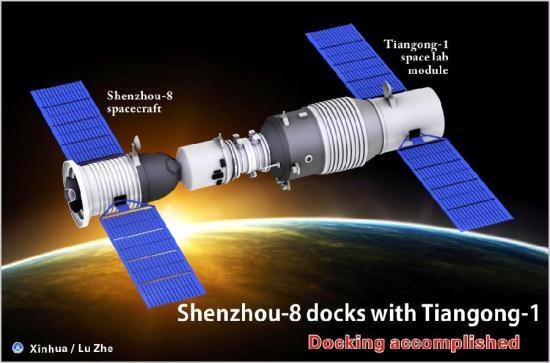
Jonathan McDowell, an astrophysicist at the Harvard-Smithsonian Center for Astrophysics who also monitors objects in orbit, said via Twitter that Tiangong-1’s reentry could be anywhere between the latitudes of 43 degrees North and 43 degrees South, which is a rather large area on our planet and are the latitudes where a majority of Earth’s population resides. That’s not especially comforting, but remember, the odds are in your favor.
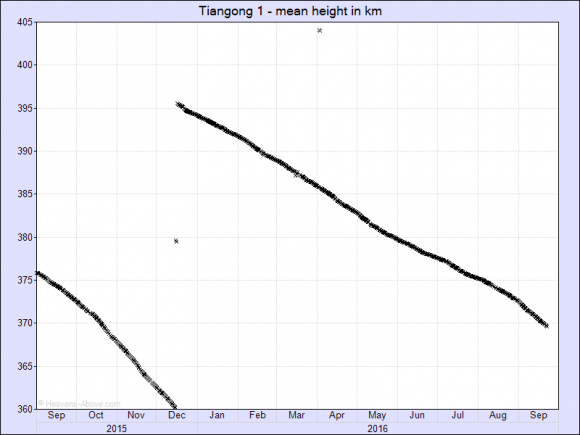
Peat now has a page on Heavens-Above showing the orbital height of Tiangong-1 and you can see how the height is reducing as a function of time. It shows there was an orbital boost in December 2015.
Tiangong-1 was launched in September 2011 and ended its functional life in March this year, when it had “comprehensively fulfilled its historical mission,” Chinese officials said. It was operational for four and a half years, which is two and a half years longer than its designed life. It was visited by the un-crewed Shenzhou-8 in 2011, and the crewed missions of Shenzhou-9 in 2012 and Shenzhou-10 in 2013. It also was used for Earth observation and studying the space environment, according to CMSE.
If you happen to capture an image of Tiangong-1, please add it to Universe Today’s Flickr pool page.


